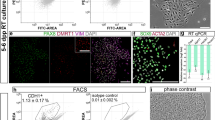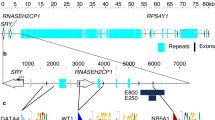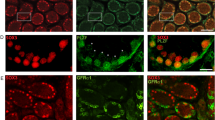Abstract
Total RNA was extracted from pooled tammar fetuses and neonatal gdnads and analysed for SPY expression using reverse transcription and polymerase chain reaction (RT-PCR). In the tammar, the gonadal primordium is first apparent at day 21 of the 26.5 day gestation. By day 25 the cytoplasmicmuclear ratio in male pre-Sertoli cells is greater than in female cells, but it is not until two days post-partum that seminiferous cords are obvious with putative Leydig cells appearing in the interstitium9. We initially tested for the presence of SRY transcripts from the day after the genital ridge is established (day 22 of gestation) until two days after the development of seminiferous tubules (day 4 post partum). Surprisingly, SRY expression was detected throughout this entire developmental period in male fetal tissue and in gonads from male pouch young (Fig. 1a). We therefore extended our sampling period from day 19 of gestation (early head-fold; ∼20 somites) to 40 days after birth and established that in the tammar SRY is expressed from at least 6 days before the appearance of Sertoli cells until long after the immature testis has fully differentiated (Fig. 1b). Thus, expression of the tammar SRY gene does not result in immediate Sertoli cell differentiation.
This is a preview of subscription content, access via your institution
Access options
Subscribe to this journal
Receive 12 print issues and online access
$209.00 per year
only $17.42 per issue
Buy this article
- Purchase on Springer Link
- Instant access to full article PDF
Prices may be subject to local taxes which are calculated during checkout
Similar content being viewed by others
References
Berta, P. et al. Genetic evidence equating SRY and the testis determining factor. Nature 348, 248–250 (1990).
Koopman, P., Gubbay, J., Vivian, N., Goodfellow, P.N. & Lovell-Badge, R. Male development of chromosomally female mice transgenic for Sry. Nature 351, 117–121 (1991).
Sinclair, A.H. et al. A gene from the human sex determining region encodes a protein with homology to a conserved DNA binding motif. Nature 346, 240–244 (1990).
Gubbay, J. et al. A gene mapping to the sex-determining region of the mouse Y chromosome is a member of a novel family of embryonically expressed genes. Nature 346, 245–250 (1990).
Foster, J.W. et al. Evolution of sex determination and the Y chromosome: SRY-related sequences in marsupials. Nature 359, 531–533 (1992).
Koopman, P., Munsterberg, A., Capel, B., Vivian, N. & Lovell-Badge, R. Expression of a candidate sex determining gene during mouse testis differentiation. Nature 348, 450–452 (1990).
Burgoyne, P.S., Buehr, M., Koopman, R., Rossant, J. & McLaren, A. Cell-autonomous action of the testis-determining gene: Sertoli cells are exclusively XY in XX-XY chimaeric mouse testes. Development 102, 443–450 (1988).
Lovell-Badge, R. Sex determining gene expression during embryogenesis. Phil. Trans. R. Soc. Lond. B. 339, 159–164 (1993).
Renfree, M.B. Sexual dimorphisms in the gonads and reproductive tract of marsupial mammals in The Differences Between the Sexes (eds Short, R. V. & Balaban, E.) 213–230 (Cambridge University Press, Cambridge, 1994).
Boyer, T.R. & Erickson, R.P. Detection of circular and linear transcripts of Sry in pre-implantation mouse embryos: differences in requirement for reverse transcriptase. Biochem. biophys. Res. Comm. 198, 492–496 (1994).
Clepet, C., Schafer, A.J., Sinclair, A.H., Palmer, M.S., Lovell-Badge, R. & Goodfellow, P.N. The human SRY transcript. Hum. molec. Genet. 2, 2007–2012 (1993).
Zwingman, T., Erickson, R.P., Boyer, T. & Ao, A. Transcription of the sex-determining region genes Sry and Zfy in the mouse preimplantation embryo. Proc. natl. Acad. Sci. U.S.A. 90, 814–817 (1993).
Ao, A., Erickson, R.P., Winston, R.M.L. & Handyside, A.H. Transcription of paternal Y-linked genes in the human zygote as early as the pronucleate stage. Zygote 2, 281–287 (1994).
Fiddler, M., Abdel-Rahman, B., Rappolee, D.A. & Pergament, E. Expression of SRY transcripts in preimplantation human embryos. Am. J. med. Genet. 55, 80–84 (1995).
Capel, B. et al. Circular transcripts of the testis-determining gene Sry in adult mouse testis. Cell 73, 1019–1030 (1993).
Sharman, G.B., Robinson, E.S., Walton, S.M. & Berger, P.J. Sex chromosomes and reproductive anatomy of some intersexual mammals. J. Reprod. Fertil. 21, 57–68 (1970).
O, W-S., Short, R.V., Renfree, M.B. & Shaw, G. Primary genetic control of sexual differentiation in a mammal. Nature 331, 716–717 (1988).
Koopman, P., Gubbay, J., Collignon, J. & Lovell-Badge, R. Zfy gene expression patterns are not compatible with a primary role in mouse sex determination. Nature 342, 940–942 (1989).
Author information
Authors and Affiliations
Rights and permissions
About this article
Cite this article
Harry, J., Koopman, P., Brennan, F. et al. Widespread expression of the testis–determining gene SRY in a marsupial. Nat Genet 11, 347–349 (1995). https://doi.org/10.1038/ng1195-347
Received:
Accepted:
Issue Date:
DOI: https://doi.org/10.1038/ng1195-347
This article is cited by
-
The evolutionary process of mammalian sex determination genes focusing on marsupial SRYs
BMC Evolutionary Biology (2018)
-
A role for estrogen in somatic cell fate of the mammalian gonad
Chromosome Research (2012)
-
Desert hedgehogis a mammal-specific gene expressed during testicular and ovarian development in a marsupial
BMC Developmental Biology (2011)
-
Oestrogen blocks the nuclear entry of SOX9 in the developing gonad of a marsupial mammal
BMC Biology (2010)
-
Somatic sex identity is cell autonomous in the chicken
Nature (2010)



